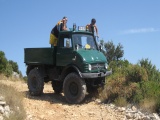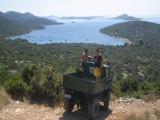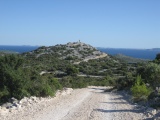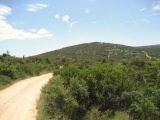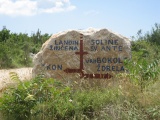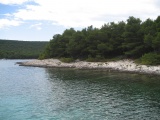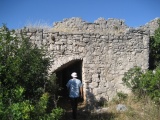Island Pasman, sport activities and excursions
The island of Pasman forms a part of the Zadar archipelago. The picturesque Pasman Channel, with many islands resembling scattered pearls, separates it from the mainland and the towns of Zadar and Biograd. The rapid stream that changes its course every 6 hours makes the sea a very clean part of the Croatian Adriatic, alredy known for its clearness and transparence. Very early humans settled in the area of Pasman /60 sq km/.
Single archeological finds witness to the way of life of the early stone age /Paleolitic/ cultivators who inhabited this part of the Adriatic. We should mention Illyric towns, gradine - primitive fortifications at elevated sites, Roman ruins, ville rusticae, various mosaics, a stone statue of St. Michael /12th century/ in Nevidjane and many others.
Beyond the village of Tkon, crowing the picturesque hill of Cokovac, is the benedictine monastery of Ss. Cosmas and Damien, erected in 1125. The monastery was the centre of Glagolic liturgy and literature. The curch, designed in the Gothic style and erected on the ruins of the older Romanesque one was built from 1369 till 1419. We must mention the Gothic Crucifixion, painted by a local painter from the end of the 14.th century. At Kraj, 3 kilometers to the north, is the Franciscan monastery /1390/, with the curch and graceful courtyard from the 16th century. The monastery was reconstructed in1557. We should also mention the Renaissance cloister, the dinning room, and the museum in which are kept several pictures of considerable value, and the panel representing the "Madonna with Child and St. John the Baptist".
The island of Pasman is covered with lavish Mediterranean vegetation - pinewoods, vineyards, olive-groves, orchards and dense evergreen growing wild, and also with some aromatic and medicine herbs. Its submarine life is very rich, with various kinds of shells and fish.
NATIONAL PARK KORNATI
Stretching along the central part of the Croatian Adriatic, are the Kornati islands. With their immense natural beauty, diverse coastlines, and preserved marine ecosystem, most of the Kornati islands were declared a National park in 1980. National park Kornati sizes about 220 km2 which consists of 89 islands, islets and reefs. National park Kornati was named after the biggest island in the group - Kornat.
Vegetation on the islands is minimal, giving the islands a bald look, however, nature still thrives with plant life on the rocks. Crystal clear water, and uncover the all kinds of reefs, shellfish and many species of fish below the surface.
The Kornati islands were populated in prehistoric times; findings of stone hatchets at the bottom of the hill Pasinka on the islands of Kornati confirm the stated. The Kornati islands were a frequent target for invaders and thieves, from the Romans and the Venetians to the aristocracy from Zadar. Although today the Kornati islands are only populated during the summer months, old field and fishing houses spread out in secluded inlets on the Kornati islands, give away the presence of their owners. There is no electricity or fresh water springs on the islands.
The Kornati islands are a real heaven for yachtsmen, divers and all those who enjoy the solitude of untouched and the magnificence of nature. There are 20 restaurants on the Kornati islands which serve fish specialities. You can get to the Kornati islands by boat (if you own or you rent), or by organised boat excursions offered by tourist agencies.
Interesting things to see:
Islet of Taljuric - because of its oval shape it looks like a plate. It is dangerous for boats, because it is often covered with water.
Island Piskera - is the second largest island in the national park, it was once the main fishing centre on the Kornati islands with a warehouse for salted fish.
Mala (little) Proversa – is a shallow passage between Dugi (long) island and the island of Katine. Ancient Roman ruins approximately 90m long are visible in the sea, which were once above sea level.
Bay of Spinuta - in the bay, leftover wall ruins are visible of an Ancient Roman salt factory or of a fish cultivating pond.

